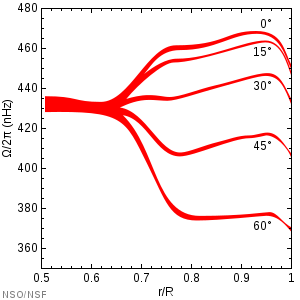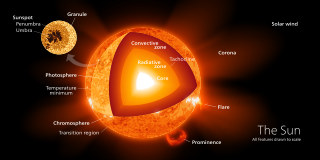964:
943:
108:
20:
85:, which do not have a radiative core and only have a convective zone, demonstrate that they maintain large-scale, solar-strength magnetic fields and display solar-like activity despite the absence of tachoclines. This suggests that the convective zone alone may be responsible for the function of the solar dynamo.
23:
Internal rotation in the Sun, showing differential rotation in the outer convective region (as a function of latitude) and almost uniform rotation in the central radiative region. The transition between these regions is called the tachocline. To convert the y-axis to period, use 500 nanoHz = 23.15
65:
indicate that the tachocline is located at a radius of at most 0.70 times the solar radius (measured from the core, i.e., the surface is at 1 solar radius), with a thickness of 0.04 times the solar radius. This would mean the area has a very large shear profile that is one way that large scale
56:
as the rotation rate changes very rapidly. The convective exterior rotates as a normal fluid with differential rotation with the poles rotating slowly and the equator rotating quickly. The radiative interior exhibits solid-body rotation, possibly due to a
331:
Charbonneau, P.; Christensen-Dalsgaard, J.; Henning, R.; Larsen, R. M.; Schou, J.; Thompson, M. J.; Tomczyk, S. (December 1999). "Helioseismic
Constraints on the Structure of the Solar Tachocline".
61:. The rotation rate through the interior is roughly equal to the rotation rate at mid-latitudes, i.e. in-between the rate at the slow poles and the fast equator. Recent results from
422:
473:
963:
1005:
767:
453:
923:
58:
928:
726:
904:
599:
119:
998:
898:
741:
634:
794:
614:
446:
78:
74:
45:
878:
848:
666:
483:
381:
340:
301:
266:
221:
97:
698:
1029:
784:
516:
239:
211:
69:
The geometry and width of the tachocline are thought to play an important role in models of the
991:
918:
833:
639:
418:
399:
356:
319:
975:
624:
533:
439:
389:
348:
309:
270:
229:
169:
858:
838:
813:
708:
653:
629:
506:
139:
62:
49:
385:
344:
305:
225:
828:
808:
803:
591:
496:
144:
93:
41:
234:
199:
1018:
873:
868:
843:
772:
762:
683:
678:
673:
576:
553:
538:
370:"Helioseismic measurement of the extent of overshoot below the solar convection zone"
243:
53:
1024:
946:
853:
823:
818:
779:
609:
604:
581:
563:
543:
159:
134:
82:
70:
200:"The Discovery of Solar-like Activity Cycles Beyond the End of the Main Sequence?"
412:
789:
736:
731:
718:
703:
688:
661:
571:
525:
164:
129:
101:
863:
693:
491:
394:
369:
174:
154:
37:
403:
360:
323:
746:
619:
888:
314:
289:
16:
Region of the Sun between the radiative interior and the convective zone
548:
124:
107:
19:
257:
Spiegel, E. A.; Zahn, J. -P. (November 1992). "The solar tachocline".
352:
216:
106:
33:
883:
435:
971:
462:
112:
290:"Large-Scale Dynamics of the Convection Zone and Tachocline"
431:
368:
Basu, Sarbani; Antia, H. M.; Narasimha, D. (March 1994).
979:
411:
Hughes, D. W.; Rosner, R.; Weiss, N. O. (2007-05-31).
81:
field. Recent radio observations of cooler stars and
911:
897:
755:
717:
652:
590:
562:
524:
515:
482:
374:Monthly Notices of the Royal Astronomical Society
52:. This causes the region to have a very large
999:
447:
8:
417:. Cambridge University Press. p. 382.
1006:
992:
521:
454:
440:
432:
393:
313:
233:
215:
111:An illustration of the structure of the
18:
190:
7:
960:
958:
198:Route, Matthew (October 20, 2016).
978:. You can help Knowledge (XXG) by
100:in 1992 by analogy to the oceanic
14:
204:The Astrophysical Journal Letters
962:
942:
941:
77:field to create a much stronger
294:Living Reviews in Solar Physics
66:magnetic fields can be formed.
1:
924:List of heliophysics missions
970:This article related to the
929:Category:Missions to the Sun
32:is the transition region of
235:10.3847/2041-8205/830/2/L27
1046:
957:
259:Astronomy and Astrophysics
937:
905:G-type main-sequence star
469:
333:The Astrophysical Journal
92:was coined in a paper by
73:by winding up the weaker
768:In mythology and culture
288:Miesch, Mark S. (2005).
395:10.1093/mnras/267.1.209
271:1992A&A...265..106S
46:differentially rotating
635:Supra-arcade downflows
181:
25:
615:Coronal mass ejection
282:Additional References
110:
22:
879:Standard solar model
849:Solar radio emission
667:List of solar cycles
414:The Solar Tachocline
315:10.12942/lrsp-2005-1
699:Magnetic switchback
386:1994MNRAS.267..209B
345:1999ApJ...527..445C
306:2005LRSP....2....1M
226:2016ApJ...830L..27R
889:Sunlight radiation
484:Internal structure
182:
42:radiative interior
26:
987:
986:
955:
954:
919:Solar observatory
834:Solar observation
732:Termination shock
648:
647:
600:Transition region
424:978-1-139-46258-7
36:of more than 0.3
1037:
1008:
1001:
994:
966:
959:
945:
944:
534:Supergranulation
522:
456:
449:
442:
433:
428:
407:
397:
364:
327:
317:
275:
274:
254:
248:
247:
237:
219:
195:
1045:
1044:
1040:
1039:
1038:
1036:
1035:
1034:
1015:
1014:
1013:
1012:
956:
951:
933:
907:
893:
859:Solar telescope
839:Solar phenomena
814:Solar astronomy
751:
713:
709:Helioseismology
644:
630:Helmet streamer
586:
558:
511:
507:Convection zone
478:
465:
460:
425:
410:
367:
330:
287:
284:
279:
278:
256:
255:
251:
197:
196:
192:
187:
180:
179:
140:Convection zone
71:stellar dynamos
63:helioseismology
50:convective zone
17:
12:
11:
5:
1043:
1041:
1033:
1032:
1027:
1017:
1016:
1011:
1010:
1003:
996:
988:
985:
984:
967:
953:
952:
950:
949:
938:
935:
934:
932:
931:
926:
921:
915:
913:
909:
908:
903:
901:
899:Spectral class
895:
894:
892:
891:
886:
881:
876:
871:
866:
861:
856:
851:
846:
841:
836:
831:
829:Solar neutrino
826:
821:
816:
811:
809:Solar activity
806:
804:Sun in fiction
801:
800:
799:
798:
797:
782:
777:
776:
775:
770:
759:
757:
753:
752:
750:
749:
744:
739:
734:
729:
723:
721:
715:
714:
712:
711:
706:
701:
696:
691:
686:
681:
676:
671:
670:
669:
658:
656:
650:
649:
646:
645:
643:
642:
640:Alfvén surface
637:
632:
627:
622:
617:
612:
607:
602:
596:
594:
588:
587:
585:
584:
579:
574:
568:
566:
560:
559:
557:
556:
551:
546:
541:
536:
530:
528:
519:
513:
512:
510:
509:
504:
499:
497:Radiation zone
494:
488:
486:
480:
479:
477:
476:
470:
467:
466:
461:
459:
458:
451:
444:
436:
430:
429:
423:
408:
380:(1): 209–224.
365:
353:10.1086/308050
339:(1): 445–460.
328:
283:
280:
277:
276:
249:
189:
188:
186:
183:
178:
177:
172:
167:
162:
157:
152:
147:
145:Radiation zone
142:
137:
132:
127:
122:
116:
115:
98:Jean-Paul Zahn
94:Edward Spiegel
40:, between the
15:
13:
10:
9:
6:
4:
3:
2:
1042:
1031:
1028:
1026:
1023:
1022:
1020:
1009:
1004:
1002:
997:
995:
990:
989:
983:
981:
977:
973:
968:
965:
961:
948:
940:
939:
936:
930:
927:
925:
922:
920:
917:
916:
914:
910:
906:
902:
900:
896:
890:
887:
885:
882:
880:
877:
875:
874:Space weather
872:
870:
869:Space climate
867:
865:
862:
860:
857:
855:
852:
850:
847:
845:
844:Solar physics
842:
840:
837:
835:
832:
830:
827:
825:
822:
820:
817:
815:
812:
810:
807:
805:
802:
796:
793:
792:
791:
788:
787:
786:
783:
781:
778:
774:
773:Lunar eclipse
771:
769:
766:
765:
764:
761:
760:
758:
754:
748:
745:
743:
740:
738:
735:
733:
730:
728:
727:Current sheet
725:
724:
722:
720:
716:
710:
707:
705:
702:
700:
697:
695:
692:
690:
687:
685:
684:Solar minimum
682:
680:
679:Solar maximum
677:
675:
674:Active region
672:
668:
665:
664:
663:
660:
659:
657:
655:
651:
641:
638:
636:
633:
631:
628:
626:
623:
621:
618:
616:
613:
611:
608:
606:
603:
601:
598:
597:
595:
593:
589:
583:
580:
578:
575:
573:
570:
569:
567:
565:
561:
555:
554:Ellerman bomb
552:
550:
547:
545:
542:
540:
537:
535:
532:
531:
529:
527:
523:
520:
518:
514:
508:
505:
503:
500:
498:
495:
493:
490:
489:
487:
485:
481:
475:
472:
471:
468:
464:
457:
452:
450:
445:
443:
438:
437:
434:
426:
420:
416:
415:
409:
405:
401:
396:
391:
387:
383:
379:
375:
371:
366:
362:
358:
354:
350:
346:
342:
338:
334:
329:
325:
321:
316:
311:
307:
303:
299:
295:
291:
286:
285:
281:
272:
268:
264:
260:
253:
250:
245:
241:
236:
231:
227:
223:
218:
213:
209:
205:
201:
194:
191:
184:
176:
173:
171:
168:
166:
163:
161:
158:
156:
153:
151:
148:
146:
143:
141:
138:
136:
133:
131:
128:
126:
123:
121:
118:
117:
114:
109:
105:
103:
99:
95:
91:
86:
84:
80:
76:
72:
67:
64:
60:
55:
51:
47:
43:
39:
35:
31:
21:
980:expanding it
969:
854:Solar System
824:Solar energy
819:Solar dynamo
780:Heliophysics
610:Coronal loop
605:Coronal hole
582:Moreton wave
564:Chromosphere
501:
413:
377:
373:
336:
332:
297:
293:
262:
258:
252:
207:
203:
193:
160:Solar corona
149:
135:Chromosphere
89:
87:
83:brown dwarfs
68:
59:fossil field
38:solar masses
29:
27:
912:Exploration
790:Solar deity
737:Heliosheath
719:Heliosphere
689:Wolf number
662:Solar cycle
526:Photosphere
265:: 106–114.
130:Photosphere
102:thermocline
1019:Categories
864:Solar time
785:In culture
742:Heliopause
694:Solar wind
625:Prominence
517:Atmosphere
502:Tachocline
217:1609.07761
185:References
175:Solar wind
170:Prominence
155:Solar core
150:Tachocline
90:tachocline
30:tachocline
1030:Sun stubs
747:Bow shock
654:Variation
620:Nanoflare
404:0035-8711
361:0004-637X
324:1614-4961
244:119111063
210:(2): 27.
88:The term
947:Category
300:(1): 1.
120:Granules
79:toroidal
75:poloidal
44:and the
763:Eclipse
756:Related
577:Spicule
549:Sunspot
544:Faculae
539:Granule
463:The Sun
382:Bibcode
341:Bibcode
302:Bibcode
267:Bibcode
222:Bibcode
125:Sunspot
592:Corona
421:
402:
359:
322:
242:
48:outer
974:is a
704:Flare
572:Plage
240:S2CID
212:arXiv
165:Flare
54:shear
34:stars
24:days.
976:stub
884:Star
795:List
492:Core
474:List
419:ISBN
400:ISSN
357:ISSN
320:ISSN
96:and
28:The
1025:Sun
972:Sun
390:doi
378:267
349:doi
337:527
310:doi
263:265
230:doi
208:830
113:Sun
1021::
398:.
388:.
376:.
372:.
355:.
347:.
335:.
318:.
308:.
296:.
292:.
261:.
238:.
228:.
220:.
206:.
202:.
104:.
1007:e
1000:t
993:v
982:.
455:e
448:t
441:v
427:.
406:.
392::
384::
363:.
351::
343::
326:.
312::
304::
298:2
273:.
269::
246:.
232::
224::
214::
Text is available under the Creative Commons Attribution-ShareAlike License. Additional terms may apply.

